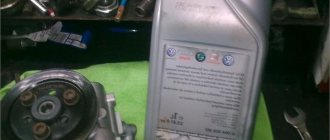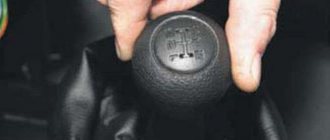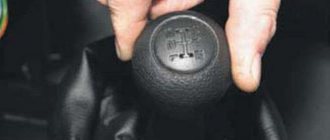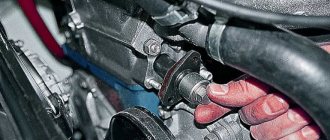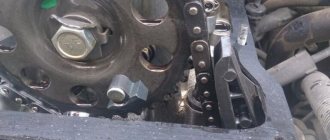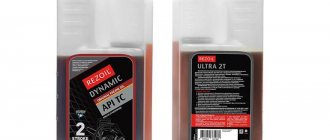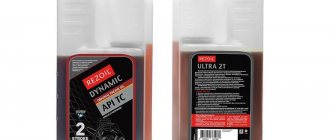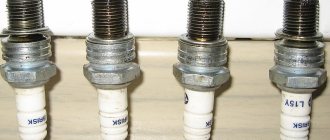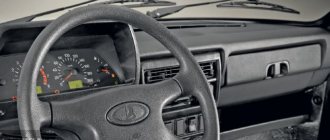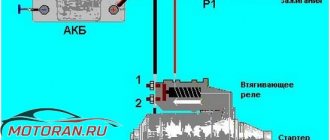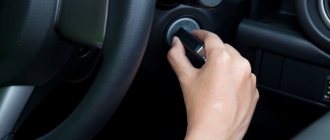Replacing the carb solved all the problems.
FOUND. Chevrolet Niva
This is to find out the reasons for the malfunction of the electrical part of the car, but do not forget about mechanical damage: Then you blow it again and reassemble it. I tried it now!
Arkhangelsk club of owners and lovers of the Chevrolet Niva car. Who knows why - in the morning you start the engine, the gas pedal...
The dynamics, of course, have worsened, but the efficiency has increased. To do this, they need to be unscrewed and inspected.
You can check it by installing a working relay. You can determine if a filter or fuel pump is faulty by hearing. Tighten the terminals well to get good contact.
When the starter is turned on, multiple clicks are heard. The reason is a malfunction of the holding winding of the traction relay, the battery is severely discharged, and the contact connections in the starter circuit are loose. The starter turns on, but its armature either does not rotate or rotates slowly. The reason is a discharged battery, broken contact connections, burnt contacts of the traction relay, dirty commutator or worn brushes, interturn or short circuit in the windings.
The starter turns on, its armature rotates, but the flywheel remains motionless. The reason is a weakening of the starter's attachment to the clutch housing, damage to the teeth of the flywheel or drive gear, slipping of the freewheel of the drive, breakage of the lever, drive ring or buffer spring of the starter drive.
The starter does not turn off after starting the engine.
If the oil level in the car has dropped, this can be determined visually using a warning lamp in the form of a can on the instrument panel. If you are sure that there is enough oil in the engine, pull out the level meter and check. Troubleshooting Having identified the problem that causes the Chevrolet Niva engine to start poorly, you can begin to fix the problem.
Knowing the source of the problem, you can draw the appropriate conclusions: Most of the above reasons have a simple nature of damage, and correcting them will not take much time. A list of the main malfunctions when the engine does not start or starts poorly, and how to eliminate them. You can light a cigarette from another car, then the generator will recharge the battery. Clean the contacts if they are oxidized and lubricate them with Lithol.
The lubricant prevents the appearance of oxide on the terminals. Tighten the terminals well to get good contact. Starter Check the starter contacts and tighten them. In the event of a malfunction, have the starter repaired to rewind the windings or install a new one.
Spark plugs Replace all 4 spark plugs with new ones, or clean them with sandpaper. But in any case, if the spark plugs have worked out, they need to be changed so that there are no problems with the engine. Refuel only at branded gas stations, and only with fuel that is suitable for this type of engine A Fuses Install new fuses.
It is better to visit an auto electrician to determine the root cause of the failure of the fuses.
Ignition relay Replace with a new relay. Broken wire of the main components Having found out which wire is broken, you need to find out the reason why this happened. After that, install it in place. Immobilizer Anti-theft system suffers from battery failure. Wire breaks rarely occur. It is necessary to replace the battery with a new one, preferably a high-quality one.
Drop the torpedo completely so it will be more visible and carefully start the car. It is possible that the left wiring is smoking, for example, the alarm... You start it right away for the second time and it works without problems and warms up. There were no problems while driving, although a couple of times it seemed like there were dips during acceleration.
I switched from RN to Lukoil, this problem disappeared: My father went to the dacha and couldn’t start it there, I wanted to take the help of the club, but a neighbor helped, they looked at all the spark plugs and they turned out to be damp. We screwed in the spare set and it started and drove fine. And since Sunday, when warming up, the speed varies from to and the warmed-up engine periodically stalls at idle, it needs a carb.
Maybe it will resolve on its own or should I add some chemicals? Who successfully cleaned the power supply system with chemicals? You need to unscrew it, blow it out and clean it. When the engine is not running, when the ignition is on, if you disconnect the wiring from it, it should click.
When the channels or jets become heavily clogged, at least go to maximum and it won’t blow out. Well, as a varinat, there is such garbage as carburetor cleaner in spray bottles.
Doesn't Start When Hot - TOP 3 Causes of Poor Engine Starting
With the arrival of hot days, more and more drivers are faced with the problem of poor engine starting when hot, after several minutes of parking. Moreover, this is a problem not only for carburetor engines - a situation where it does not start when hot can await both owners of cars with injection engines and diesel cars. Only the reasons are different for everyone. Here we will try to collect them and identify the most common ones.
When a hot carburetor engine does not start
Why is it difficult to start when hot and what to do?
the volatility of gasoline is mainly . The bottom line is that when the engine warms up to operating temperature, the carburetor also heats up, and after turning it off, within 10-15 minutes, the fuel begins to evaporate, making it difficult to start the car.
Installing a textolite spacer can help here, but it does not give 100% results.
In such a situation, pressing the gas pedal to the floor and purging the fuel system will help to start a hot engine, but not longer than 10-15 seconds, since fuel can flood the spark plugs. If the question concerns the Zhiguli, then the fuel pump may also be to blame, since Zhiguli gasoline pumps really do not like heat and sometimes completely refuse to work when overheated.
When an injection engine does not start
Since an injection engine is somewhat more complex than a carburetor engine, there will be more reasons why such an engine will not start. In particular, they may be malfunctions of the following components and mechanisms:
- Coolant temperature sensor. In hot weather, it may fail and supply incorrect information to the ECU, in particular, that the coolant temperature is higher than normal.
- Crankshaft position sensor (CPS). Its failure will lead to incorrect operation of the ECU, which in turn will not allow the engine to start.
- Mass air flow sensor (MAF). In hot weather, the sensor may not cope with the tasks assigned to it, since the temperature difference between the incoming and outgoing air masses will be insignificant. In addition, there is always the possibility of its partial or complete failure.
- Fuel injectors. Here the situation is similar with a carburetor engine. The fine fraction of gasoline evaporates at high temperatures, forming an enriched fuel mixture. Accordingly, the engine cannot start normally.
- Fuel pump. In particular, it is necessary to check the operation of its check valve.
- Idle air control (IAC).
- Fuel pressure control.
- Ignition module.
Next, let's move on to considering the possible reasons for poor hot starting in cars with diesel engines.
When a hot diesel engine has trouble starting
Unfortunately, diesel engines can also sometimes fail to start when hot. Most often, the causes of this phenomenon are malfunctions of the following components:
- Coolant sensor. Here the situation is similar to that described in the previous section. The sensor may fail and, accordingly, transmit incorrect information to the ECU.
- Crankshaft position sensor. The situation is similar to an injection engine.
- Mass air flow sensor. Likewise.
- High pressure fuel pump. In particular, this can happen due to significant wear of the bushings and oil seal of the pump drive shaft. Air enters the pump from under the seal, making it impossible to build up operating pressure in the pre-plunger chamber.
- Diesel engine idle system.
- Fuel pressure control.
- Ignition module.
Now we will try to summarize the information provided so that it is easier for you to find the cause of the breakdown if it happens to your car.
DTOZH
fuel injectors
injection pump plunger pair
Three main reasons for poor hot starting
So, according to statistics, the main reasons for poor engine starting after idle time at high temperatures are:
- An enriched fuel mixture, which is formed due to low-quality gasoline (its light fractions evaporate, and a kind of “gasoline fog” is obtained).
- Faulty coolant sensor. At high ambient temperatures, there is a possibility of its incorrect operation.
- Faulty ignition. It may be incorrectly set or there may be problems with the ignition switch.
We will also provide you with a table where we tried to visually show which components can cause problems, and what needs to be checked in different types of engines.
Types of engines and their characteristic causesCarburetorInjectionDiesel
| Poor quality fuel, evaporation of its light fractions |
| Faulty coolant sensor |
| Crankshaft position sensor |
| Mass air flow sensor |
| Fuel injectors |
| Fuel pump |
| High pressure fuel pump |
| Idle speed control |
| Fuel pressure control |
| Diesel idle system |
| Ignition module |
Why does a warm engine stall?
Some motorists are faced with a situation where an already running and warmed-up engine suddenly stalls. Moreover, this happens after the sensor has recorded a set of normal operating temperatures. There may be several reasons for this. Next, we will consider them in more detail, and also indicate what needs to be done in this or that case.
- Poor quality fuel . This situation is typical, for example, if you are driving away from a gas station, and after a short period of time the engine begins to “cough”, the car jerks and stalls. The solution here is obvious - drain the low-quality fuel, bleed the fuel system and replace the fuel filter. It is also advisable to replace the spark plugs, but if they are new, you can get by by blowing them out. Naturally, you shouldn’t go to such a gas station in the future, but if you have saved your receipt, you can go there and make a claim about the quality of the fuel.
- Fuel filter . If the engine stalls, you should also check the condition of the fuel filter. And if according to the regulations it is already necessary to replace it, then this must be done, regardless of whether it is clogged or not yet.
- Air filter . The situation is similar here. The engine may “choke” on the rich mixture and stall shortly after starting. Check its condition and replace if necessary. By the way, this way you can also reduce fuel consumption.
- Gasoline pump . If it does not operate at full capacity, the engine will not receive enough fuel and, accordingly, will stall after a while.
- Generator . If it completely or partially fails, it stops charging the battery. The driver may not immediately notice this fact, start the engine and drive off. However, it will only drive until the battery is completely discharged. Unfortunately, it will no longer be possible to start the engine on it again. In some cases, you can try to tighten the alternator belt. If this procedure does not help, you need to call a tow truck or call your friends to have your car dragged to a garage or service station.
Reason #1. Fuel pump
Or rather, not only the fuel pump, but also the check valve in the fuel module. The fact is that for safety reasons, the ECU turns off the fuel pump after a couple of seconds if the engine does not rotate. This prevents fuel from leaking during an accident.
Therefore, if the check valve does not work correctly or the pump itself has reduced performance, then it does not have enough time to pump up the necessary pressure to start the engine. And you have to turn on the ignition several times and give the pump more time. Usually the second time the engine starts. Moreover, the colder it is, the more clearly this problem manifests itself, since in warm weather less fuel is required to start and the fuel itself evaporates more easily from the valves, thereby making it easier to start the engine.
In the fuel module, the function of a check valve is performed by the fuel pressure regulator. It maintains fuel pressure within specified limits and prevents fuel from flowing back into the tank when the fuel pump is turned off.
Finding it separately is difficult, but possible. You can buy it using this link.
If the pump performance is weak, the pump itself must be replaced (the so-called bulb)
To check and diagnose this reason, it is enough to measure the fuel pressure. How to easily do it yourself is shown here
If the check shows problems with fuel pressure, then do not rush to immediately order a pump or pressure regulator. Remove the fuel module from the vehicle and inspect it. The fact is that sometimes connecting hoses burst and because of this, problems arise with fuel pressure
Chevrolet Niva doesn't start well
Every owner of a vehicle experiences situations where you are in a hurry to go to work in the morning, get behind the wheel of your car, and then the unexpected happens - the car does not start. All car owners know what an unpleasant situation this is.
To solve this problem, it is necessary to find out the reason, and what could be the reason in such a car, with a large number of different parts? Even experienced car owners sometimes ask this question. After all, you will never guess which part has failed and how to eliminate this reason.
In order to understand this issue, we will consider all the sources of malfunctions in the Chevrolet Niva, how to identify them correctly, what is necessary to resolve them and why this happened.
To troubleshoot a car problem, you first need to find out the source why the car won’t start. The driver can be helped in identifying damage by various sensors on the instrument panel, an external inspection of the car, or the sound that is made when the key is turned. So, the main problems that cause the engine to start poorly and the car will not start may be the following malfunctions.
Causes of electrical damage:
- The car battery has become unusable or discharged. This basis is primary for all types of cars.
- The starter became unusable due to getting wet, or, as they say, it served its purpose.
- Poor contact from the battery due to oxidation of the terminals.
- Defective spark plugs, which could occur in the following cases:
- Poor quality fuel, which led to them getting wet.
- The spark plugs have already worn out and a large gap has formed.
- The fuse has blown.
- The ignition relay or something else has failed.
- The wire supplying the main components of the car (for example, power supply to the starter or injector) has come off.
- The immobilizer does not work.
If for any reason the anti-theft system does not work, the car will not be able to start until the immobilizer malfunction problem is resolved.
Mechanical faults:
- There is no fuel in the gas tank. This may not only be the fault of the driver, because there is a possibility of a breakdown of the fuel level sensor. Not every driver counts fuel by the number of kilometers driven.
- Clogging of the fuel filter or fuel pump, which leads to breakdown of the latter.
- Nozzle clogged.
- Insufficient oil level in the engine or antifreeze in the radiator. Causes the engine to overheat.
- The idle speed control is damaged.
How to find out the cause of the problem
Knowing the most common sources for which the Chevrolet Niva does not start well, now you need to find out how to correctly determine the damage? After all, there are many reasons, and it will take a considerable amount of time to check all this. Finding out the reason why your iron horse does not want to work is done with the help of your eyes, ears and car tips.
You can call a technician to your home, who will determine the damage in a matter of minutes, and sometimes even seconds. And for this clarification, you will have to pay a lot of money. You can take your car to a service station by asking a friend to help with transportation. It will cost much less than calling a technician to your home, but you will spend a lot of time. Therefore, your best bet for determining damage is you and your head.
Only if all possible reasons have been verified, then it is necessary to contact a specialist. Perhaps your car requires a major check of the entire system.
Knowing all the shortcomings why the Niva does not respond to turning the key in the ignition, you can easily identify them:
- You can determine whether the battery is damaged by checking the presence of power in the car when you turn the key. If at this moment the entire panel, as they say, is silent, then you need to charge the battery or replace it with a new one. Recharging may take a couple of hours if the battery is in good condition, but if the electrolyte density is low, then you only need to purchase a new battery.
- We can talk about failure of the starter to perform its function if it is definitely determined that the battery is in good working order. It is possible that when you turn the key, the starter will click but will not start. In this case, this also indicates that the battery does not provide the current necessary to start the engine. To find out 100% the cause of the starter, you can connect a voltmeter and ammeter to its terminals and measure the current and voltage, respectively.
- Damage to the contacts on the battery can be detected by opening the hood and visually assessing their oxidation. Often, drivers simply do not notice oxidation due to the rubber lining on the terminals.
- Spark plugs can be checked by unscrewing them from the cylinder block and performing a visual inspection. They should not be wet, and black carbon deposits indicate their damage. The normal color of candles should be dark brown.
- The fuses can be checked by removing the cover and visually inspecting them. If a fuse is blown, it will be visible and will most likely be completely melted. You can also ring each of them using a tester.
- Damage to the ignition relay can be determined visually; if there is no reaction when turning the key, the relay should be replaced. You can check it by installing a working relay.
- You can determine the lack of contact on the main components of car parts by visual inspection. It is necessary to tighten the contacts on the starter, the injector power supply and the fuel pump. The positive wire that powers the electronic injection system comes directly from the battery terminal with a separate wire.
- Often the problem with the immobilizer can be a low battery. You just need to install a new battery.
This is to find out the reasons for the malfunction of the electrical part of the car, but do not forget about mechanical damage:
- The indicator on the instrument panel will help you find out if there is no fuel in the tank. If the fuel gauge is at zero and the warning light in the form of a gas pump is on, then the source of the trouble has been detected and there is no need to open the hood.
- You can determine if a filter or fuel pump is faulty by hearing. If you hear a strong buzzing sound (in the rear trunk area), then most likely the filter or pump is clogged, which is not delivering fuel to the engine.
- A clogged injector can be seen on the instrument panel; the red “CHEK ENGINE” indicator lamp should light up. It indicates any damage to the injector or engine error.
- If the oil level in the car has dropped, this can be determined visually using a warning lamp in the form of a can on the instrument panel. If you are sure that there is enough oil in the engine, pull out the level meter and check.
Trouble-shooting
Having identified the problem that causes the Chevrolet Niva engine to start poorly, you can begin to fix the problem. Knowing the source of the problem, you can draw the appropriate conclusions: are you able to fix the error yourself, without requiring additional help? Most of the above reasons are of a simple nature of damage, and correcting them will not take much time. For the convenience of solving the problem that causes the Shevik to not start, information on how to eliminate them is recorded in tabular form in Table No. 1.
Table No. 1. A list of the main malfunctions when the engine does not start or starts poorly, and how to eliminate them.
| Malfunction | Remedy |
| battery | Replace or recharge the battery. You can light a cigarette from another car, then the generator will recharge the battery. Clean the contacts if they are oxidized and lubricate them with Litol. The lubricant prevents the appearance of oxide on the terminals. Tighten the terminals well to get good contact. |
| Starter | Check the starter contacts and tighten them. In the event of a malfunction, have the starter repaired to rewind the windings or install a new one. |
| Spark plug | Replace all 4 spark plugs with new ones, or clean them with sandpaper. But in any case, if the spark plugs have worked out, they need to be changed so that there are no problems with the engine. Refuel only at branded gas stations, and only with fuel that is suitable for this type of engine (A-95). |
| Fuses | Install new fuses. It is better to visit an auto electrician to determine the root cause of the failure of the fuses. |
| Ignition relay | Replace with a new relay. |
| Broken wires of main components | Having found out which wire is broken, you need to find out the reason why this happened. After that, install it in place. |
| Immobilizer | The anti-theft system suffers from battery failure. Wire breaks rarely occur. It is necessary to replace the battery with a new one, preferably a high-quality one. |
| Lack of fuel | Pour quality fuel into the tank and wait until the fuel pump pumps it into the engine. |
| Clogged fuel filter and fuel pump | Replace the gas filter with a new one. Remove the fuel pump and clean it. |
| Lack of oil or antifreeze | Add oil to the engine and find out the reason for its disappearance. The gasket through which the oil escapes may be damaged. Add antifreeze to the expansion tank and check for fluid leaks. |
Drivers often encounter the problem of poor engine starting in winter, during periods of severe frost. These frosts damage not only the battery, but also all parts where water may have entered. This problem is also often encountered in extreme heat, when the engine overheats and then has difficulty starting.
Now knowing why the Chevrolet Niva may not start, you can easily go looking for a problem. Having identified the breakdown, you will solve the problem of poor engine starting by 50%. And the solutions are now known, so you can hit the road.
Source: https://chnivaremont.ru/dvigatel/ploxo-zavoditsya-niva-chevrole.html
Impact of long periods of downtime
There is an opinion that nothing will be done to the car during a long parking period. However, everything happens the other way around. Long-term parking greatly affects the car, more than many thousands of kilometers. Sometimes we are talking about just a few weeks. After this short period of time, you can also see negative consequences. And if we consider long-term parking, it will be even worse. Let's consider the negative factors that appear after a car has been idle for a long time.
Change in oil properties
Modern types of oils can be stored for a very long time without loss of quality. But after pouring it into the engine, the shelf life is significantly reduced. This is due to the fact that modern oils include many additives, and during engine operation the oil is exposed to high temperatures, resulting in a “stratification” effect.
This effect is not felt when the engine is constantly running, since the oil is shaken and mixed. But if the car sits for a long time, sediment appears in the oil and its performance properties are lost. Experts do not recommend starting the engine with old oil, as this will cause the engine to seize. If there is a long break in the operation of the machine, then it is necessary to flush the engine, as well as change filters and oils to new ones.
Loss of gasoline quality
Fuel has an expiration date, just like motor oil. When gasoline is poured into the tank, its shelf life quickly decreases. This occurs due to the formation of condensation in the tank due to frequent temperature changes. The gasoline is diluted with this condensate. Its volume directly depends on the volume of gasoline in the tank. The less gasoline in the tank, the more condensation forms.
In this case, there are two solutions to the problem: you need to add high-quality fuel to the tank, or remove the old gasoline and fill it with fresh one.
Reason for battery drain
Among the negative factors from parking a car for a long time, the battery was no exception. If it is not charged in a timely manner, the density of the electrolyte decreases. Moreover, it does not take much time for the battery to discharge. Even a small consumer can draw battery energy within a few days. This problem can be eliminated by performing high-quality charging. If the battery is already old and more than five years old, then it must be replaced with a new one.
Loss of elasticity of seals
When parked for a long time, rubber bands, gaskets, and seals lose their parameters. This is due to the fact that when the car is parked, oil and lubricants flow into the crankcase and engine sump. The rubber seals then begin to be exposed to the negative effects of air. As a result, they dry out and become covered with cracks, and multiple cracks appear at the installation sites.
Connecting hoses are cracking
If parked for too long, more than four years, rubber hoses, like seals, lose their characteristics. They crack and dry out, often not visible during normal inspection.
Many microcracks appear on the connecting hoses; when starting the engine, they may not show themselves, but after some time they will show themselves. When parked for a long time, you need to carefully inspect the hoses for the appearance of various defects on them. If the car has been parked for more than four years, then the hoses need to be replaced; while driving they can burst and cause a lot of trouble.
Reason for needing brake fluid replacement
This working fluid has special hygroscopic characteristics; it absorbs moisture. During operation, it is exposed to high temperatures. If there is a high moisture content in this liquid, it can boil, as a result of which the brake system will stop working, which will lead to an emergency situation on the road.
Brake fluid requires replacement once every few years if the car is driven regularly. After a long period of parking, the brake fluid should be replaced first.
Checking the brake discs
These parts are subject to intense corrosion over time when the car is parked. It is usually easy to remove, you just need to drive and brake a few times.
Before driving your car, you need to inspect the brake pads; they can become unstuck over time. When parked for more than three years, it is recommended to replace the pads with new ones.
Chevrolet Niva won't start: reasons, how to fix it - AutoExpert
It happens that the starter works fine, but the engine stubbornly refuses to start, although the Check lamp does not light up. In such cases, if we talk about the VAZ-2123 engine, we can immediately name 10 different reasons.
All of them will be quite real, and not at all from the category of “contacts have oxidized.” In general, sometimes the Chevrolet Niva does not start, but the starter turns the shaft properly, and the reason should not be looked for there.
Well, let's try to learn to recognize different reasons, that is, to distinguish one from the other.
Example in the video: the APS immobilizer blocked the engine because it was in learning mode!
Chevrolet Niva does not start: three different sensors
The crankshaft position sensor will not indicate its failure in any way. The Check light will not light up, the engine will simply not start. Finding this sensor is easy if you know where the alternator belt is (see photo).
DPKV sensor connector
Here we check the serviceability of the wiring, as well as the distance from the sensor to the “teeth” (0.8-1.2 mm).
The second suspicious element will be the temperature sensor. The engine may not start only if it breaks. In this case, the electric fan should work without turning off. That is, a break in the DTOZH sensor circuit is easily recognized.
Element “6” is DTOZH
In the photo there is a sensor, and to get to it, the air duct is removed.
If the idle speed control malfunctions, the engine on a Chevrolet Niva does not start, but the starter turns. By the way, the Check lamp may be on. Diagnostics:
- Just lightly press the gas and turn on the starter;
- If the engine starts, but without gas it does not start, it means the IAC is faulty.
Set of "electrical" reasons
The first step in diagnostics: remove the cap from any spark plug, install spark plug A17DVRM and, holding it with pliers, turn on the starter.
How to remove the cap
The spark plug must be held by the hexagon, the pliers must have insulated handles, and the spark plug body must touch the “ground”. As a result, a spark can be observed. If there is no spark, it means:
- The ECM is faulty or is not receiving voltage;
- The ignition coil module burned out;
- High voltage wires are faulty.
The drawing for point “1” is given below.
Power supply point to the ECM
The presence of a spark “in the air” does not guarantee its presence in the engine. The spark plugs may be faulty, the gap may be incorrect, etc.
The number of reasons why the Chevrolet Niva does not start, but the starter turns, has increased to 7.
Immobilizer blocks engine starting
If the immobilizer has been activated, then sooner or later it will block the engine from starting. It happens like this: when you turn on the ignition, the indicator flashes for 15 seconds, then goes out. And then the system produces sound signals.
“2” – immobilizer lamp
The APS-4 module can be disabled. For this you need a “red” training key. Well, the APS-6 unit cannot be turned off. Usually you have to flash the ECM.
There is no need to panic right away: perhaps the blocking occurs due to irregularities in the “reader” wiring.
Fuel rail
On the ramp next to regulator 5 there is a control fitting 3. It is closed with a cap, which is unscrewed and then carefully pressed on the spool.
Ramp drawing
If fuel flows, it means it is entering the ramp. But perhaps the necessary pressure is not created. Reasons: clogged filter cylinder, pump malfunction, etc.
https://www.youtube.com/watch?v=NQy_mOVq0h0
The pressure should be 350 kPa (3.5 bar). It is controlled by unscrewing the spool and installing a pressure gauge. Before checking, you need to reduce the pressure!
If fuel does not flow, notice whether the pump turns on when the key is turned to the “I” mark. When the ignition is turned on “cold”, the pump should run for 10 seconds.
Additional mounting block
Know that fuse F2 and relay P4 are responsible for turning on the pump. There is also a main relay P5, and all these elements are located in a block mounted on the same bracket with the ECM (see photo).
Even if the pressure is normal, the injectors may be clogged. In addition, their wiring may be damaged.
Case from practice
What happens if water gets into gasoline? In the summer - nothing. And in winter, the power supply system can become clogged with ice. All elements are at risk, from the pump to the injector valves!
Fuel supply line filter
A small amount of water is always present in fuel. If this number is increased, this is what happens:
- The first start always goes without problems;
- Then, after leaving the car in the parking lot, after 2-3 hours the owner will no longer be able to start the engine without repairs.
All of the above applies to any injection internal combustion engine, including the VAZ-2123. And the “first candidate for failure” will be the fuel filter. It is located under the bottom of the Chevrolet Niva and is encased in aluminum (see photo). However, this is done on many cars.
Pumping up excess air
One smart book says that the engine may not start due to the fact that the intake manifold draws in too much air. This means you need to check the fastening of all pipes. But not only.
Vacuum brake booster
The source of “excess air” may be a faulty VUT. The starter turns, the engine on the Chevrolet Niva does not start, and the reason, it turns out, must be sought in the brake system!
We won't look for anything. Let's do it simpler:
- The vacuum supply hose is removed from the amplifier side (see drawing);
- The hole in the hose is closed with a finger and one test run is performed;
- The engine starts, which means the cause has been found.
That's the whole trick. We wish you success!
Despite its apparent simplicity, defects in the air supply system are difficult to detect. Check the fit of the hoses on the fittings and the tightness of all clamps.
Chevrolet Niva won't start, we look for and eliminate the reasons
Malfunctions of the electrical part First of all, for all types and models of cars, you should pay attention to the battery - it may be worn out or the Chevrolet Niva may simply not start. Finding out the reasons in the mechanical part So, next you need to check the fuel pump and filter. When you turn the key, you can diagnose battery problems.
Manuals → Chevrolet → Niva (Chevrolet Niva). The engine will not start. Problems starting a car engine...
In the event of a malfunction, have the starter repaired to rewind the windings or install a new one. The fuses can be checked by removing the cover and visually inspecting them. Next, we check the injection time and ignition timing when scrolling.
But perhaps the necessary pressure is not created. Dark brown is a normal candle color. Try to set fire to the merged substance, or just smell it.
The reason is a violation of contact connections, a break or short circuit in the starter switching circuits, a malfunction of the traction relay. When the starter is turned on, multiple clicks are heard. The reason is a malfunction of the holding winding of the traction relay, the battery is severely discharged, and the contact connections in the starter circuit are loose.
The starter turns on, but its armature either does not rotate or rotates slowly. Case from practice What happens if water gets into gasoline?
And in winter, the power supply system can become clogged with ice. All elements are at risk, from the pump to the injector valves! Fuel supply line filter There is always a small amount of water in the fuel.
If this number is increased, this is what will happen: The first start always goes without problems; Then, after leaving the car in the parking lot, after an hour the owner will no longer be able to start the engine without repairs.
Electrical faults
To do this, they need to be unscrewed and inspected. They should be dry and free of black soot. They can also be inspected. If any of them are melted or cracked, their service life has passed.
Sometimes the ignition relay fails. If absolutely nothing happens when you turn the key, most likely this particular element has failed. If the car does not start due to the immobilizer, apparently the battery in the key fob is simply dead.
Finding out the reasons in the mechanical part So, next you need to check the fuel pump and filter. If when you turn the key you hear a buzzing sound in the area of the rear seat and luggage compartment, these are the elements that are faulty. In principle, nothing complicated. Once the fault has already been found, getting rid of it is quite simple.
Almost any of the above reasons can be easily eliminated.
In other words, if you are looking for the reason why the engine refuses to start, you need to start not with replacing the fuel filter or checking the DPKV connector, but with something completely different.
Let's bring final clarity to this issue. What does an engine need to work? Only I would add: All defects will ultimately result in these two.
To do this, it is not enough to simply unscrew the spark plug and, connecting it to a high-voltage wire and placing it on ground, crank the engine.
The gap on the spark plug is such that at atmospheric pressure, breakdown will occur even with a half-dead ignition coil. And it is impossible to assess the quality of sparking by eye.
Possible faults
The wind cools the carburetor when the car is running; the air-fuel mixture does not form when the engine is turned off. A hot unit increases the temperature of the carburetor, gasoline slowly evaporates, the air filter becomes clogged, fuel lines, fluid passages become clogged, the amount of gasoline decreases and starting the car becomes difficult.
Problems with injection systems:
- The coolant sensor fails and the operation of the automated system becomes difficult.
- Injector malfunctions rarely occur; holes appear, the pressure in the valve decreases, and the circulation of the working fluid becomes difficult.
- The air flow sensor is broken, the gasoline is oversaturated or insufficiently filled with oxygen, the fire is contained.
Operating principle of TPS
There are two types of devices: resistive and non-contact. They differ in design, operating principle and service life.
- Resistive TPS is a variable resistor, the resistance of which changes as the slider moves along the tracks. Due to their simple design and affordable price, they are most common in the automotive industry. The Chevrolet Niva rolls off the assembly line with just such resistive devices.
- Non-contact TPS is based on a circuit that includes a magnetic field sensor and a microcontroller. They last longer and consume less electricity than resistive ones. However, contactless devices are more expensive, and the semiconductor microcontroller can burn out due to sudden voltage surges in the on-board network.
The installation location and operating principle of the TPS does not depend on the design. It is mounted on the throttle shaft. When the throttle position changes, the output voltage at the sensor changes from 0.7 to 4 volts. Due to this, the ECU receives information from the degree of opening of the damper. Based on the information received from the sensor, the composition of the air-fuel mixture is formed. Therefore, the throttle response and efficiency of the engine depend on the performance of the TPS.
When the immobilizer is activated, one way or another, it will block the engine from starting. This happens when, with the ignition on, the indicator starts flashing for 15 seconds and then goes out. Next, the system sends sound signals.
It’s time to disable the module on the Chevrolet Niva APS-4. Here you will need a training key (red), but APS-6 cannot be turned off. Basically, the ECM is forced to flash. There is no need to panic: the blocking is probably due to a broken reader in the cable.
Problems of domestic cars
Many domestically produced cars also have trouble starting when the engine is hot. The problem is in the design, but this time the gas tank. The fuel pump, which heats up during operation, should, in theory, cool down a little during operation. This occurs due to the liquid that moves through its body. During the summer heat, the liquid heats up, so cooling does not occur, which leads to disastrous consequences.
A faulty high-pressure fuel pump (HPF) stops working, which leads to a disruption in the fuel supply to the engine. Subsequent turns of the key and pushes will not help, but there are several “old-fashioned” methods. The device needs to cool down.
Design Features
A novice car enthusiast is recommended to study the operation of an injection engine. The injector includes a system that injects gasoline. After familiarizing yourself with the device, you won’t have to contact a service center for minor problems, but rather fix them at home yourself. The fuel supply is considered distributional, because gasoline is injected into each cylinder using a specific injector.
The VAZ 2115 is based on the VAZ 21099 model. In the new car, unlike the previous one, the shape of the hood, rear and front bumpers, a new configuration of the front wings, as well as improved aerodynamics of the body have changed. A spoiler was placed on the trunk lid - a wing. The exterior decoration was decorated with plastic elements, since metal ones were corroded by corrosion. For added safety, the model was supplemented with a brake signal and rear lighting.
Thanks to the electronically controlled injection power unit located under the hood, the electrical circuit of the VAZ 2115 differs significantly from the 99 modification.
The supporting structure of the car body is welded, metal, integral. The drive is front transverse. It has a 5-speed gearbox and the front wheels are connected to the drive. The engine has a capacity of 1.5 liters and is a four-cylinder, petrol, four-stroke and in-line. Distributive fuel injection systems are controlled electronically.
Under the rear seats, behind the bottom, there is a fuel tank. Gasoline is supplied from the gasoline pump located in it. The pressure level in it should not fall below 3.2 bar.
Ignition system and starter connection diagram
The VAZ wiring diagram includes a VAZ ignition system module, consisting of two high-voltage transformers and two electronic control units. They are in a durable plastic case, from which 4 high voltage wires are removed. They have a connection that creates a synchronous passage of a spark entering the cylinders of the power plant.
The VAZ 2114 ignition module consists of a two-spark coil and is of the block type. The ignition switch turns on a relay that sends a signal to the controller. The latter is the control element of the injection system for starting the fuel pump. It is connected to the cleaning filter with a flexible hose. After this, gasoline is supplied to the fuel rail, from which the fuel is supplied to the injectors.
The pinout of the VAZ ignition switch is in itself. It has an anti-theft device. When the lock socket illumination is on and the engine is running, the anti-theft locking device blocks the VAZ starter from re-engaging.
The starter connection diagram consists of:
- the starter itself;
- generator;
- rechargeable batteries;
- ignition switch;
- two relays.
The engine for the VAZ 2114 is also a four-stroke injector, in-line with an 8-valve unit. Its camshaft is at the top. Operates on gasoline fuel and is equipped with 4 cylinders. It is cooled with a special liquid solution. The engine compartment contains a motor located perpendicular to the direction of movement.
The VAZ wiring diagram has electronics that control the injection system. It operates at low voltage, so it can be damaged very easily by electrostatic discharge. To prevent this from happening, do not touch the circuit elements on the boards or the ECU plugs.
Fuel supply filter
There is always a small amount of moisture in the fuel. When this amount is increased, this is what can happen:
- the first start always goes without problems;
- After leaving the car in the parking lot, after 2-3 hours the driver will no longer be able to start the engine without repairs.
Everything mentioned should be attributed to the injection internal combustion engine. And here the fuel filter will be a candidate for failure. So, in the Chevrolet Niva it is located under the bottom in aluminum form. By the way, this is thought out on many machines.
This section is not under development
autodelo. info
autodelo. info Passenger Motorcycles Trucks and Commercial Engines
- For novice drivers
- Code of Administrative Offenses
- Region codes
- Legal issues
- Insurance
- Adviсe
- News
- Test Drive
- Interesting
- Online services
- about the project
- Rules
- Contacts
“Car catalog and all the news from the world of car lovers”
ALFA ROMEO AUTO UNION AUDI AUSTIN BEDFORD BMW CHRYSLER CITROËN DAF DAIHATSU DAIMLER DODGE FIAT FORD GMC HONDA INNOCENTI ISUZU IVECO JAGUAR LADA (VAZ) LANCIA MAN MAZDA MERCEDES-BENZ MG MITSUBISHI MORRIS NISSAN NSU OPEL PEUGEOT PORSCHE RENAULT ROVER SA AB SEAT SKODA SUBARU SUZUKI TALBOT TOYOTA TRIUMPH VAUXHALL VOLVO VOLKSWAGEN ZASTAVA AVIA BARKAS BORGWARD CHEVROLET DACIA EBRO GAZ SANTANA SSANGYONG STEYR TATA PIAGGIO HYUNDAI KIA DAEWOO WARTBURG TRABANT AC RENAULT TRUCKS FERRARI LAMBORGHINI ROLLS-ROYCE MASERATI RELIANT PONTIAC FSO FORD USA PROTON BUGATTI AUTOBIANCHI HOLDEN LOTUS MORGAN FORD OTOSAN ALPINE GLAS MOSKVICH BENTLEY BUICK CADILLAC GEO LEXUS MEGA PLYMOUTH PREMIER TVR ALPINA ASIA MOTORS ASTON MARTIN JEEP WESTFIELD SMART ZAZ OLDSMOBILE LINCOLN MAHINDRA ARO LDV AIXAM BERTONE BITTER BRISTOL CALLAWAY CARBODIES CATERHAM CHECKER DALLAS DE LOREAN DE TOMASO GINETTA HINDUSTAN HOBBYCAR ACURA HUMMER INDIGO IRMSCHER ISDERA JENSEN LIGIER MARCOS MCLAREN METROCAB MIDDLEBRIDGE MINELLI MINI INFINITI OLTCIT OSCA PANOZ PANTHER PAYKAN PERODUA RANGER RAYTON FISSORE BOND AUSTIN-HEALEY RILEY WOLSELEY SAO SHELBY SIPANI SPECTRE STANDARD TOFAS UAZ UMM VECTOR WIESMANN YULON PUCH LAND ROVER MAYBACH ASHOK LEYLAND ASKAM (FARGO/DESOTO) AMC LANDWIND (JMC) GEELY SUN BEAM SPYKER KTM HILLMAN YUGO DONGFENG ( DFAC) EUNOS FORD ASIA / OCEANIA FOTON GREAT WALL MITSUOKA PININFARINA LTI IRAN KHODRO (IKCO) FPV MAXUS (SAIC MOTOR) TESLA TAZZARI ARTEGA THINK NOBLE FISKER KING LONG ABARTH MIA DS (CAPSA) STREETSCOOTER RUF MICROCAR DFSK DS ZENOS CARS IZH
autodelo. info
autodelo. info Passenger Motorcycles Trucks and Commercial Engines
- Traffic rules
- Code of Administrative Offenses
- Region codes
- Legal issues
- Adviсe
- News
- Reviews
- Interesting
- Online services
